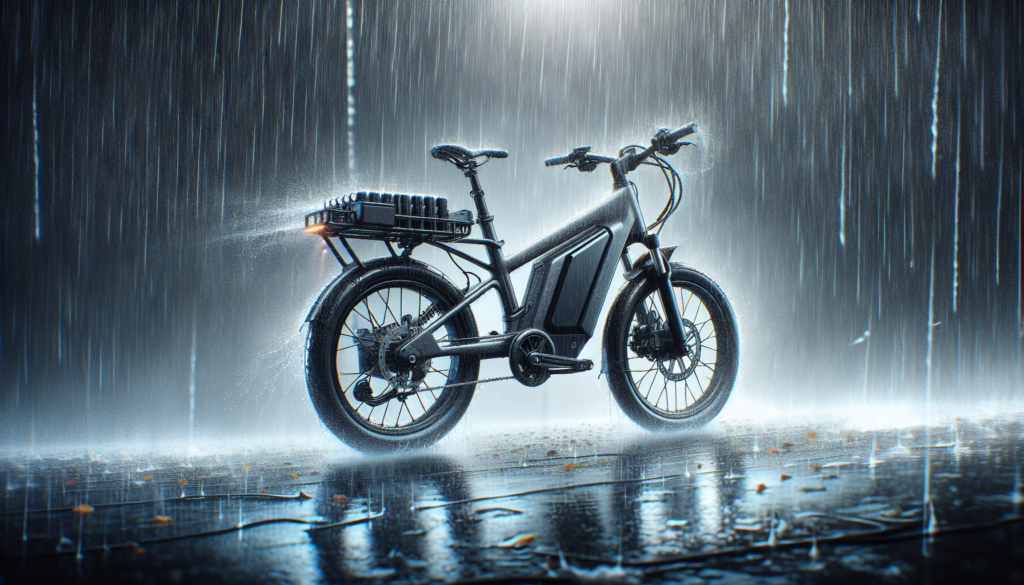Ebikes have revolutionized the way we commute and explore the outdoors, offering an eco-friendly and efficient means of transportation. However, one crucial question remains: are ebikes waterproof? Whether you’re an adventurous rider who loves to bike through rainstorms or just want the peace of mind knowing that your ebike can withstand unexpected showers, it’s important to understand the waterproof capabilities of these modern marvels. Let’s explore the truth behind ebikes and their waterproofness, ensuring that your rides remain dry and enjoyable.
Can Ebikes Be Used in the Rain?
Understanding Waterproof Ratings
When it comes to using ebikes in the rain, understanding waterproof ratings is crucial. Waterproof ratings are assigned to electronic devices, including ebikes, to indicate their level of protection against water ingress. The most commonly used waterproof rating system is the IP (Ingress Protection) rating, which consists of two digits. The first digit represents the level of protection against solid objects, while the second digit indicates the level of protection against water.
Components That Need Extra Protection
While ebikes are designed to withstand various weather conditions, there are certain components that require extra protection when encountering rain. These include the battery, motor, electronics, and brake system. As these are vital components of the ebike, it is essential to take necessary measures to protect them from water damage.
Waterproofing Measures on Ebikes
Ebikes often come equipped with waterproofing measures to ensure they can be used in rainy conditions. These measures can include sealed battery enclosures, water-resistant motor housings, and sealed connectors. Manufacturers incorporate these features to provide a certain level of waterproofness, but it is important to check the specifications and ratings provided by the manufacturer to ensure the ebike’s suitability for rainy conditions.
Proper Maintenance for Rainy Conditions
To ensure the longevity and performance of your ebike in rainy conditions, proper maintenance is essential. Regular inspections, component replacements, and scheduled servicing can play a significant role in preventing water damage. Additionally, proper drying and cleaning techniques after exposure to rain can keep your ebike in optimal condition.
How Does Water Affect Ebike Components?
Battery Performance in Wet Conditions
Water can have a detrimental effect on an ebike’s battery performance. Exposure to water can lead to short circuits, corrosion, and reduced battery efficiency. This can result in a decrease in power output and overall range. Proper waterproofing measures and maintenance can help mitigate these issues and preserve battery performance.
Motor Functionality in Wet Conditions
Water can also impact the functionality of the ebike’s motor. Moisture ingress can lead to motor corrosion, decreased power output, and even motor failure. The effectiveness of waterproofing measures, such as sealed motor housings and protective coatings, can help protect the motor from water damage and maintain its performance.
Electronics and Water Damage
The electronics of an ebike are particularly vulnerable to water damage. Water ingress can cause short circuits, corrosion, and malfunctioning of electronic components. This can result in various issues, including loss of power, erratic behavior, and potential safety hazards. Ensuring proper waterproofing of connectors, circuit boards, and other electronic components is crucial to protect against water damage.
Brake System Performance in Wet Conditions
The brake system is another vital component that can be affected by rain. Wet conditions can lead to reduced braking power, delayed response times, and increased wear on brake pads. Proper maintenance, including regular inspections and adjustments, can help maintain optimum brake performance in wet conditions. Additionally, using high-quality brake pads and choosing an ebike with excellent waterproofing measures can contribute to safer and more reliable braking.
Factors That Determine Ebike Waterproofness
Level of Waterproofing from the Manufacturer
The level of waterproofing provided by the manufacturer plays a significant role in determining an ebike’s suitability for rainy conditions. Manufacturers may incorporate various waterproofing measures, such as sealing techniques, gasketing, and use of water-resistant materials. It is important to check the manufacturer’s specifications and waterproof ratings to ensure the ebike meets your requirements.
Materials Used in Ebike Construction
The materials used in the construction of an ebike can greatly impact its waterproofness. High-quality materials, such as corrosion-resistant metals and water-resistant plastics, can enhance the ebike’s ability to withstand rain. Additionally, proper sealing and gasketing techniques can further enhance the waterproofing capabilities of an ebike.
Sealing and Gasketing Techniques
The effectiveness of the sealing and gasketing techniques used in an ebike can significantly contribute to its waterproofness. Well-designed seals and gaskets can prevent water from entering critical components, such as battery enclosures and motor housings. Manufacturers may utilize specialized techniques, such as compression seals and O-rings, to ensure a watertight seal.
IP Ratings and their Significance
IP (Ingress Protection) ratings are a standardized system used to indicate the degree of protection provided by an ebike against water ingress. The higher the IP rating, the greater the protection against water. For example, an ebike with an IPX4 rating is protected against splashing water, while an ebike with an IPX7 rating can withstand temporary immersion in water. Checking the IP rating can provide valuable insights into an ebike’s waterproofness.
Waterproofing Measures for Ebike Owners
Using Waterproof Accessories
One way to enhance the waterproofness of your ebike is by using waterproof accessories. These accessories, such as waterproof bags, covers, and fenders, can offer additional protection to critical components and electronic devices. They help shield the ebike from direct exposure to rain and minimize the risk of water damage.
Applying Protective Coatings and Sealants
Applying protective coatings and sealants to susceptible areas of your ebike can provide an extra layer of protection against water damage. There are various products available specifically designed for waterproofing electrical connections, battery enclosures, and motor housings. These coatings and sealants create a barrier that prevents water from reaching sensitive components and reduces the risk of corrosion.
Storing and Parking the Ebike
Proper storage and parking practices can help minimize the exposure of your ebike to rain. Whenever possible, store your ebike in a covered, dry area to protect it from direct rainfall. If you don’t have access to indoor storage, consider using a waterproof cover to shield the entire ebike. When parking your ebike outdoors, try to choose a location that offers some level of protection, such as under a canopy or against a wall.
Are All Ebikes Waterproof?
Not all ebikes are inherently waterproof. The level of waterproofness will vary depending on the manufacturer, model, and specifications. While many ebikes are designed with waterproofing measures to withstand rainy conditions, it is crucial to check the IP ratings and manufacturer’s specifications before assuming an ebike is completely waterproof. Taking the necessary waterproofing measures and following proper maintenance practices can increase an ebike’s ability to handle rain.
What Happens If Your Ebike Gets Wet?
Immediate Actions to Take
If your ebike gets wet, there are immediate actions you can take to minimize the potential damage. Firstly, turn off the power immediately to prevent any electrical issues. Disconnect the battery and remove any accessories or removable components. This will help prevent water from further penetrating into the electrical system or causing additional damage.
Drying and Cleaning the Ebike
After taking immediate actions, it is crucial to properly dry and clean your ebike. Use absorbent towels or cloths to remove excess moisture from the frame, components, and electrical connections. Pay close attention to areas where water may have accumulated. Use a mild detergent and water solution to gently clean the ebike, ensuring that no moisture remains. Allow the ebike to thoroughly dry before reconnecting the battery and accessories.
Preparing Your Ebike for Rainy Conditions
Checking and Replacing Worn out Parts
Before using your ebike in rainy conditions, it is important to check for any worn out parts that may compromise its waterproofness. Inspect seals, gaskets, and connectors for signs of deterioration or damage. Replace any worn out parts to maintain the ebike’s waterproof integrity.
Greasing and Lubricating Components
Greasing and lubricating components is another essential step in preparing your ebike for rainy conditions. Applying waterproof grease or lubricant to critical parts, such as bearings and drivetrain, can help repel water, prevent corrosion, and maintain smooth operation. Regular greasing and lubrication should be included in your routine maintenance.
Securing Loose Wiring
Loose wiring can be more susceptible to water damage, leading to electrical issues and potential hazards. Before riding in the rain, ensure all wiring connections are secure and properly insulated. Use zip ties or clips to neatly organize and secure any loose wiring, reducing the risk of water ingress and potential damage.
Importance of Regular Maintenance
Preventing Water Damage with Regular Inspections
Regular maintenance is key to preventing water damage and ensuring the longevity of your ebike. Conducting routine inspections, especially after riding in rainy conditions, can help identify any potential issues or areas that require attention. Check for signs of water ingress, corrosion, or wear and address any concerns promptly.
Replacing Damaged Components
If you discover any damaged components during your inspections, it is important to replace them promptly. Damaged components can compromise the waterproofness and overall functionality of your ebike. Replace any corroded connectors, worn out seals, or damaged electronics to maintain optimal performance.
Scheduled Servicing for Waterproofing Checks
In addition to regular inspections and component replacement, scheduled servicing with a professional can further ensure the waterproofing integrity of your ebike. These servicing appointments can include specialized checks for water damage, thorough cleaning, and applying fresh protective coatings or sealants. Scheduled servicing can be especially beneficial if you frequently ride your ebike in rainy conditions.

Waterproofing Kits and Products
Types of Waterproofing Kits Available
There are various waterproofing kits available in the market designed specifically for ebikes. These kits often include waterproof sealants, sprays, tapes, and coatings. They provide an opportunity to enhance the waterproofness of your ebike by providing additional layers of protection to critical components and electrical connections.
Application Process and Longevity
The application process of waterproofing kits can vary depending on the product and its intended use. Some kits may require simple spray-on applications, while others may involve more intricate steps, such as disassembling and reassembling certain components. The longevity of the waterproofing provided by these kits can also vary, depending on the product quality and the specific conditions in which the ebike is used.
Recommended Brands and Products
While there are numerous brands and products available, researching and selecting reputable brands and products can enhance the effectiveness of your waterproofing endeavors. Some recommended brands for waterproofing kits and products for ebikes include WD-40 Specialist Bike Wet, Park Tool PolyLube 1000, and 3M Silicone Lubricant.
Conclusion
Using ebikes in the rain is possible, but understanding waterproof ratings, taking proper maintenance measures, and incorporating waterproofing techniques are crucial for their performance and longevity. While not all ebikes are inherently waterproof, manufacturers implement various measures to protect vital components from water damage. As an ebike owner, it is your responsibility to ensure the waterproofness of your ebike by using accessories, applying protective coatings, and following maintenance practices. Remember to check the manufacturer’s specifications, conduct regular inspections, and replace damaged components to prevent water damage. By taking these steps, you can enjoy the benefits of riding your ebike even in wet conditions while minimizing the risk of water-related issues.


